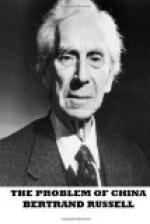Subsequent years, for which I have not the exact figures, have been less prosperous.
I cannot discover any evidence of incompetence in Chinese railway administration. On the contrary, much has been done to overcome the evils due to the fact that the various lines were originally constructed by different Powers, each following its own customs, so that there was no uniformity, and goods trucks could not be moved from one line on to another. There is, however, urgent need of further railways, especially to open up the west and to connect Canton with Hankow, the profit of which would probably be enormous.
Mines are perhaps as important as railways, for if a country allows foreign control of its mineral resources it cannot build up either its industries or its munitions to the point where they will be independent of foreign favour. But the situation as regards mining is at present far from satisfactory. Mr. Julean Arnold, American Commercial Attache at Peking, writing early in 1919, made the following statement as regards China’s mineral resources:—
China is favoured with a wonderful wealth in coal and in a good supply of iron ore, two essentials to modern industrial development. To indicate how little China has developed its marvellous wealth in coal, this country imported, during 1917, 14,000,000 tons. It is estimated that China produces now 20,000,000 tons annually, but it is supposed to have richer resources in coal than has the United States which, in 1918, produced 650,000,000 tons. In iron ore it has been estimated that China has 400,000,000 tons suitable for furnace reaction, and an additional 300,000,000 tons which might be worked by native methods. During 1917, it is estimated that China’s production of pig iron was 500,000 tons. The developments in the iron and steel industry in China are making rapid strides, and a few years hence it is expected that the production of pig iron and of finished steel will be several millions of tons annually.... In antimony and tin China is also particularly rich, and considerable progress has taken place in the mining and smelting of these ores during the past few years. China should jealously safeguard its mineral wealth, so as to preserve it for the country’s welfare.[102]
The China Year Book for 1919 gives the total Chinese production of coal for 1914 as 6,315,735 tons, and of iron ore at 468,938 tons.[103] Comparing these with Mr. Arnold’s figures for 1917, namely 20,000,000 tons of coal and 500,000 tons of pig iron (not iron ore), it is evident that great progress was made during those three years, and there is every reason to think that at least the same rate of progress has been maintained. The main problem for China, however, is not rapid development, but national development. Japan is poor in minerals, and has set to work to acquire as much as possible of the mineral wealth of China. This is important to Japan, for two different reasons: first, that only industrial development can support the growing population, which cannot be induced to emigrate to Japanese possessions on the mainland; secondly, that steel is an indispensable requisite for imperialism.




